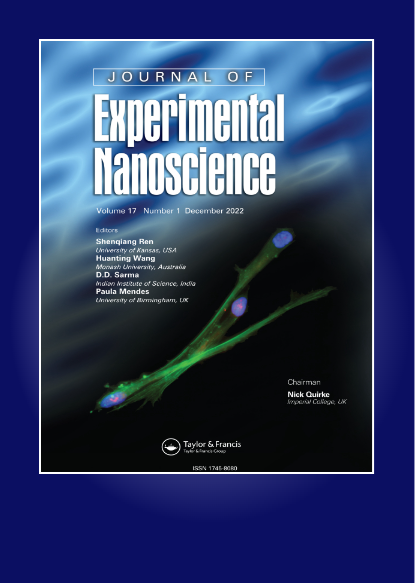Oak gum mediated sustainable synthesis of gold nanoparticles (Au NPs): evaluation of its antioxidant and anti-colon cancer effects
IF 2.6
4区 材料科学
Q2 CHEMISTRY, MULTIDISCIPLINARY
引用次数: 5
Abstract
Abstract Herein, we represent the bio-synthesis of gold nanoparticles (Au NPs) employing Oak gum extract as the green template, an efficient natural and non-toxic reductant and stabilizer based on its phytochemicals. The characterization of as-synthesized Au NPs was performed through Fourier transformed infrared spectroscopy (FT-IR), scanning electron microscopy (SEM), transmission electron microscopy (TEM), energy dispersive X-ray spectroscopy (EDS), elemental mapping, UV-Vis and X-ray diffraction (XRD). TEM analysis explored the average particle size being 10-15 nm. The as-developed material was biologically explored in the inhibition of human colon cancer. Cytotoxicity of assessed over standard colon cancer cell line HT-29 and Caco-2. Cell viability of the two cell lines showed excellent outcomes, as observed by MTT assay. Futhermore, the Au@O. Gum nanocomposite was employed in the determination of the antioxidant properties following DPPH radical scavenging potential in presence of butylated hydroxytoluene (BHT) as the positive control and the result was compared to the raw Oak gum which resulted the scavenging activity as 21.54 and 54.56% respectively. The obtained results evidently validate the Au@O. Gum material as a potent colon cancer protective drug for the treatment of human colon cancer.橡树胶介导的金纳米粒子(Au-NPs)的可持续合成:其抗氧化和抗克隆癌症作用的评价
摘要在此,我们介绍了以橡树胶提取物为绿色模板的金纳米粒子(Au NPs)的生物合成,橡树胶提取物是一种基于其植物化学物质的高效天然无毒还原剂和稳定剂。通过傅里叶变换红外光谱(FT-IR)、扫描电子显微镜(SEM)、透射电子显微镜(TEM)、能量色散X射线光谱(EDS)、元素图谱、UV-Vis和X射线衍射(XRD)对合成的Au NPs进行了表征。TEM分析发现平均粒径为10-15 nm。对as-开发的材料在抑制人类结肠癌癌症方面进行了生物学探索。评估的超过标准的结肠癌细胞系HT-29和Caco-2的细胞毒性。通过MTT分析观察到,两种细胞系的细胞活力显示出优异的结果。此外Au@O.以丁基羟基甲苯(BHT)为阳性对照,采用树胶纳米复合材料测定了DPPH自由基清除能力后的抗氧化性能,并与清除活性分别为21.54%和54.56%的生橡树胶进行了比较。所得结果明显验证了Au@O.树胶材料作为一种有效的癌症保护药物,用于治疗人类癌症。
本文章由计算机程序翻译,如有差异,请以英文原文为准。
求助全文
约1分钟内获得全文
求助全文
来源期刊

Journal of Experimental Nanoscience
工程技术-材料科学:综合
CiteScore
4.10
自引率
25.00%
发文量
39
审稿时长
6.5 months
期刊介绍:
Journal of Experimental Nanoscience, an international and multidisciplinary journal, provides a showcase for advances in the experimental sciences underlying nanotechnology and nanomaterials.
The journal exists to bring together the most significant papers making original contributions to nanoscience in a range of fields including biology and biochemistry, physics, chemistry, chemical, electrical and mechanical engineering, materials, pharmaceuticals and medicine. The aim is to provide a forum in which cross fertilization between application areas, methodologies, disciplines, as well as academic and industrial researchers can take place and new developments can be encouraged.
 求助内容:
求助内容: 应助结果提醒方式:
应助结果提醒方式:


